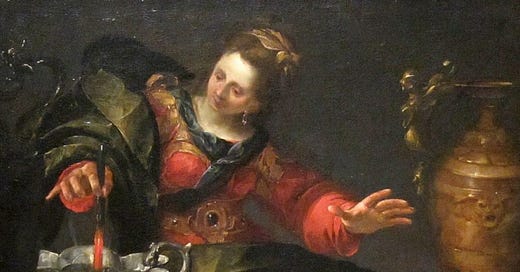Wishing You a Happy Yule!
A season's greeting, wherein the intrepid holiday cook may find historical recipes for spiced wine
Hello, friends—
It is freezing cold here in the Atlanta area—20 degrees this morning, brrr!—and I am enjoying the 21st century comfort of central heat and very much looking forward to using the fireplace in my new home soon! I’m a day late with this missive because I’ve been utterly immersed in childcare and finishing a revision of a book proposal—more on that soon, I hope—but I wanted to take a moment to wish you all a Happy Yule today!
One of my favorite things to do to celebrate Yule is to make a traditional spiced wine, so I’m sharing two recipes I love, with any luck, in time to include in your seasonal celebrations!
First, this very cool historical recipe for hippocras, which I’ll be trying for the first time this year, and the page from the popular London cookbook it was published in! Hippocras is the Roman name for spiced wine, the first recipes for which appeared in the Holy Roman Empire during about the 14th century.
Traditional Hippocras
Take to a pottle of wine an ounce of cinamon, an ounce of ginger, an ounce of nutmegs, a quarter of an ounce of cloves, seven corns of pepper, a handfull of rosemary flowers, and two pound of sugar.
—Robert May, The Accomplisht Cook, Or, The Art and Mystery of Cookery, 1660

There is nothing here to indicate it should be heated, so I’ll be assuming this recipe is one of the ones that just expects you to let the ingredients sit for a day at room temperature. Hippocras can be served hot or cold. This version appears to be a large batch and very sweet, so I am going to make a smaller batch with a single bottle of red, adding spices to taste, and reducing the sugar drastically.
The wine I usually make during Yule, and—let’s be real, will probably also make this year—is glühwein, the German version of the winter mulled wine that’s still popular today in various incarnations across Europe, though it goes by many different names—svařák in Prague, gløgg in Scandinavia, and so on.

Fun fact: in the version of The Book of Gothel that went to copyediting, several scenes depicted Haelewise drinking glühwein, until the German medievalist who helped me check the book for historical accuracy informed me that exactly zero recipes found in 12th c. German manuscripts mention mulled wine, so it was super unlikely anyone drank it. Especially not peasants, because spices were extremely expensive. Oops!
Regardless of whether it was consumed in the 12th century, I still love glühwein, so I’m sharing the recipe I use, which I’ve cobbled together from several recipes I’ve tried over the years.
Traditional Glühwein
Ingredients
4 cinnamon sticks
8 whole cloves
8 whole star anise
pinch of nutmeg
1/8 cup sugar (or to taste)
1 bottle of spätburgunder or other dry red wine
kirschwasser, the classic German cherry liqueur (to taste)
1 orange, slicedInstructions
Slice orange into thin wedges.
Put everything except the kirschwasser into a pot.
Simmer for 15 minutes on low, then add the kirschwasser to taste and stir. (You don’t want it to evaporate.)
Let cool slightly, then spoon or ladle into glass mugs.
If you try either of these, let me know what you think in a reply or the comments!
That’s it for this winter! It’s back to my book proposal for me until tomorrow afternoon, when I’ll be starting a much-needed holiday break.
I truly hope that you enjoyed the solstice yesterday, and that you are staying warm and cozy and enjoying time with your families.
Warmly,
Mary




I'm intrigued by the peppercorns in the first recipe. Might have to try this!